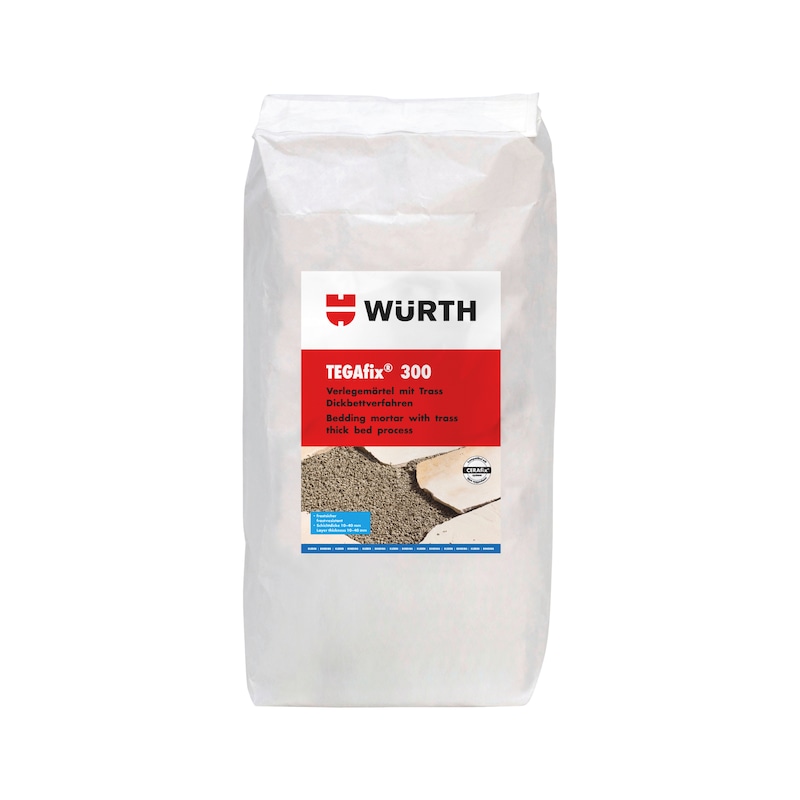Trass laying mortar thick-bed process TEGAfix 300
Trass laying mortar, thick bed method
MORT-(TEGAFIX 300)-TRASS-THICKBEDMETHOD
price per selected packing unit | Individual prices for customers after login
Register now and access more than 125,000 products
- Very good working properties
- Prevents discolouration
- Modified with trass
- Reduces the risk of lime bloom
- Waterproof
- Frost-resistant
- Sets hydraulically
- NM III according to DIN EN 18580
- M 10 according to DIN EN 998-2
EMICODE EC1plus: Very low emissions: The EMICODE classification system distinguishes the environmental and health compatibility of construction products. The lowest-emission products bear the EC1plus mark.
- The fresh mortar contains Portland cement and turns strongly alkaline when it comes into contact with water and moisture
- Please observe the hazardous substance label and the latest version of the safety datasheet
- EMICODE EC1plus: Very low emissions: The EMICODE classification system distinguishes the environmental and health compatibility of construction products. The lowest-emission products bear the EC1plus mark.
EMICODE EC1plus: Very low emissions: The EMICODE classification system distinguishes the environmental and health compatibility of construction products. The lowest-emission products bear the EC1plus mark.
The usage instructions are recommendations based on the tests we have conducted and on our experience; carry out your own tests before each application. Due to the large number of applications and storage and processing conditions, we do not assume any liability for a specific application result. Insofar as our free customer service provides technical information or acts as an advisory service, no responsibility is assumed by this service except where the advice or information given falls within the scope of our specified, contractually agreed service or the advisor was acting with deliberate intent. We guarantee the consistent quality of our products. We reserve the right to make technical changes and further develop products. Please observe the technical data sheet!
Datasheets(X)
- For laying outdoors
- For laying on floors
Prevents discolouration when laying the following using the thick-bed process:
- Natural stone (paving slabs and sheeting)
- Stairs
- Cotto tiles
- Natural dimension stone
- Concrete dimension stones (e.g. Terrazzo)
- Ceramic tile and slab coverings
For laying on heating screed
Caution:
- Not suitable for transparent natural stones or those with a tendency to discolour
- Lay only on cement-based substrates
- In a clean container, mix Würth dry mortar with clean tap water for approx. 3 minutes until there are no lumps
- It is recommended to use a 600 rpm stirrer with a spiral or double disc stirrer
- First use a contact slurry to completely cover the pre-wetted substrate
- Apply the laying mortar to the contact slurry using the "wet on wet" technique until it reaches the required height
- A contact layer is to be applied across the entire reverse side of the material to be laid (natural stone, ceramic tiles, slabs and similar materials). The material is then also to be laid "wet on wet" into the desired thick bed, tapped flush and aligned
- The tile or slab should always be laid into a complete bed of mortar (cavities may lead to damage)
- Scrape out and clean the joints thoroughly before the mortar bed cures
- Apply in accordance with DIN 18 157, part 1
- Observe ATV DIN 18352
- Apply only as much mortar as is needed for the number of ceramic tiles and slabs etc. that can be laid into the fresh mortar bed within the working/open time
- Do not stir additional water into mortar that is firming up
Weight of content | 25 kg |
Chemical basis | Cement and mineral additives |
Standards | EN 998-2 |
Colour | Grey |
Min./max. processing temperature | 5 to 25 °C |
Processing time | 1 h |
Application conditions | at min. 5°C and max. 80% relative humidity |
Application quantity in weight/area/conditions | 1.7 kg/m² / for 10-mm layer thickness |
May be walked on after max. | 24 h |
May be walked on in following conditions | at 20°C and 50% relative humidity |
Groutable after | 4 d |
Grouting condition | at 20°C and 50% relative humidity |
Full load capacity/conditions | 28 d / at 20°C and 50% relative humidity |
Shelf life from production/conditions | 12 Month / cool and frost-free storage area, in sealed original container |
Sustainability | Pollutants / Emissions |
Select RAL-colour code
!! NOTE: On-screen visualisation of the colour differs from real colour shade!!



